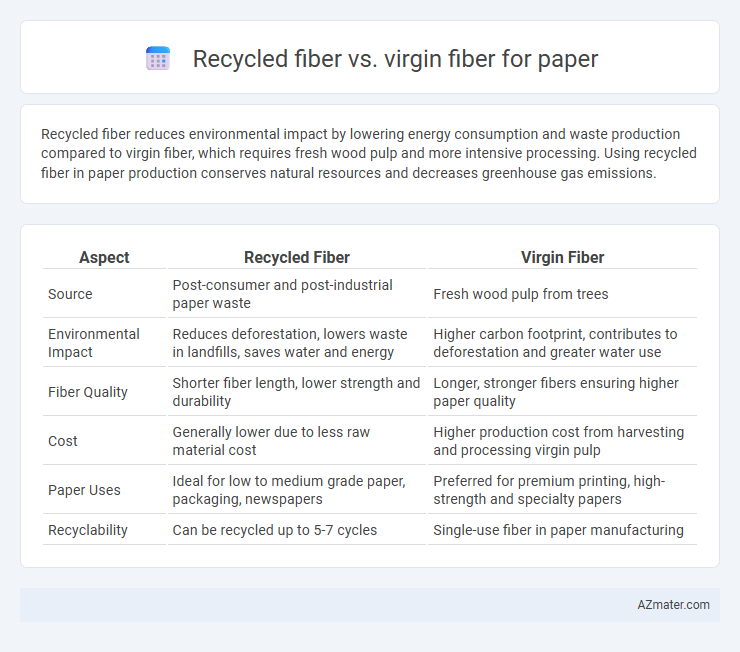Recycled fiber reduces environmental impact by lowering energy consumption and waste production compared to virgin fiber, which requires fresh wood pulp and more intensive processing. Using recycled fiber in paper production conserves natural resources and decreases greenhouse gas emissions.
Table of Comparison
| Aspect | Recycled Fiber | Virgin Fiber |
|---|---|---|
| Source | Post-consumer and post-industrial paper waste | Fresh wood pulp from trees |
| Environmental Impact | Reduces deforestation, lowers waste in landfills, saves water and energy | Higher carbon footprint, contributes to deforestation and greater water use |
| Fiber Quality | Shorter fiber length, lower strength and durability | Longer, stronger fibers ensuring higher paper quality |
| Cost | Generally lower due to less raw material cost | Higher production cost from harvesting and processing virgin pulp |
| Paper Uses | Ideal for low to medium grade paper, packaging, newspapers | Preferred for premium printing, high-strength and specialty papers |
| Recyclability | Can be recycled up to 5-7 cycles | Single-use fiber in paper manufacturing |
Introduction to Recycled Fiber and Virgin Fiber
Recycled fiber in paper production originates from post-consumer and post-industrial waste, reducing environmental impact by minimizing deforestation and lowering energy consumption compared to virgin fiber. Virgin fiber is derived directly from freshly harvested trees, offering higher strength and brightness but contributing to greater resource depletion and carbon emissions. Understanding the distinctions between recycled and virgin fibers is essential for sustainable paper manufacturing and environmental conservation strategies.
Key Differences Between Recycled and Virgin Fiber
Recycled fiber in paper production is derived from post-consumer or industrial waste, reducing the demand for new raw materials and lowering environmental impact, whereas virgin fiber comes directly from fresh wood pulp, offering higher strength and brightness. The fiber length in recycled paper is generally shorter, leading to slightly weaker paper quality compared to virgin fiber, which maintains longer, intact fibers for durability. Virgin fibers require more energy and water during processing, while recycled fibers contribute to waste reduction and conserve resources but may involve complex deinking and cleaning processes.
Environmental Impact Comparison
Recycled fiber significantly reduces the demand for virgin fiber, leading to lower deforestation rates and conservation of natural habitats. The production of paper from recycled fiber consumes up to 60% less energy and emits fewer greenhouse gases compared to virgin fiber processing. Additionally, recycled fiber minimizes water usage and reduces landfill waste, enhancing overall sustainability in paper manufacturing.
Resource Consumption and Sustainability
Recycled fiber significantly reduces resource consumption by saving approximately 60-70% of water and 40% of energy compared to virgin fiber production, making it a more sustainable option. Virgin fiber requires fresh wood pulp, contributing to deforestation and higher carbon emissions, whereas recycled fiber minimizes landfill waste and lowers greenhouse gas output. Utilizing recycled fiber supports circular economy principles, promoting sustainable forestry management and reducing environmental impact in paper manufacturing.
Paper Quality and Performance
Recycled fiber in paper production often contains shorter fibers and residual contaminants, which can reduce paper strength, brightness, and smoothness compared to virgin fiber. Virgin fiber provides superior paper quality with higher tensile strength, better opacity, and enhanced printability, making it ideal for premium paper products. The choice between recycled and virgin fiber impacts performance metrics such as tear resistance and stiffness, critical factors for specific paper applications.
Cost and Economic Considerations
Recycled fiber significantly reduces raw material costs by utilizing post-consumer waste, leading to lower expenses in the paper production process compared to virgin fiber, which requires extensive logging and pulping of fresh wood. Economic considerations also include energy savings, as recycling paper typically consumes less energy than producing virgin pulp, resulting in decreased operational costs. However, recycled fiber may require higher maintenance of machinery due to contaminants, potentially offsetting some cost benefits in the long term.
Supply Chain and Availability
Recycled fiber supply depends heavily on local collection systems and sorting efficiency, which can cause fluctuations in availability and quality, impacting paper production timelines. Virgin fiber relies on stable forestry operations and well-established logging and transportation networks, offering more consistent supply but raising sustainability concerns. Supply chain disruptions in either fiber type can lead to increased costs, requiring manufacturers to balance availability, environmental impact, and market demand when choosing between recycled and virgin materials.
Applications and End-Use Suitability
Recycled fiber, commonly used in packaging, newsprint, and tissue papers, offers sustainability benefits and is ideal for products requiring moderate durability. Virgin fiber provides superior strength and purity, making it preferred for high-quality printing papers, food packaging, and specialty applications demanding high tensile strength and brightness. End-use suitability depends on factors such as print quality, product lifespan, and environmental impact, with recycled fibers excelling in eco-friendly mass-market items and virgin fibers dominating premium or performance-critical paper products.
Certifications and Industry Standards
Recycled fiber in paper production often meets stringent certifications such as FSC Recycled, SFI Recycled, and Blue Angel, ensuring environmentally responsible sourcing and processing. Virgin fiber paper typically adheres to standards like FSC Chain of Custody and PEFC, which confirm sustainable forest management and traceability from harvest to product. Both fibers must comply with industry standards such as ISO 14001 for environmental management and EN 643 for recovered paper quality to guarantee sustainability and performance in paper manufacturing.
Future Trends in Fiber Sourcing for Paper
Future trends in fiber sourcing for paper emphasize a growing shift towards recycled fiber due to increasing environmental regulations and consumer demand for sustainability. Advances in recycling technology improve fiber quality and reduce reliance on virgin wood pulp, making recycled fibers more cost-effective and competitive. Innovations in bio-based and alternative fiber sources, such as agricultural residues and fast-growing plants, are also expected to supplement traditional virgin fiber supplies, enhancing circularity in the paper industry.

Infographic: Recycled fiber vs Virgin fiber for Paper
 azmater.com
azmater.com